Greetings! Today, I invite you to embark on a flavorful journey as we compare two renowned varieties of black tea: Darjeeling tea and Keemun tea. These teas have captivated tea enthusiasts with their distinct characteristics and alluring flavors.
Darjeeling tea, famously harvested in the serene Darjeeling Province of India, boasts high elevations and a cool climate known for producing exceptional tea leaves. Meanwhile, Keemun tea, grown in China’s Anhui province, entices with its smoky and fruity aroma. Both teas have their loyal followers who appreciate the unique qualities they bring to the cup.
Key Takeaways:
- Darjeeling tea and Keemun tea are two popular varieties of black tea.
- Darjeeling tea offers a light and floral taste with muscatel notes.
- Keemun tea has a slightly smoky and fruity aroma with a balanced, mild flavor.
- Darjeeling tea is grown in the Darjeeling Province of India, while Keemun tea is produced in the Anhui province of China.
- Both teas have their own distinctive production methods and growing regions that contribute to their unique flavors.
The Flavors of Darjeeling Tea
Darjeeling tea is renowned for its delicate and distinct flavors that captivate tea enthusiasts around the world. Each cup of Darjeeling tea offers a truly unique tasting experience, making it a favorite among connoisseurs.
The flavors of Darjeeling tea can be described as light, floral, and vibrant, with delightful muscatel notes. It is often referred to as the “Champagne of Teas” for its elegant and refined taste.
The tea undergoes different harvests, known as flushes, which contribute to its diverse flavor profiles. The first flush Darjeeling tea, harvested early in the year, exhibits a lighter color and a milder taste. It is cherished for its delicate and refreshing character.
The second flush Darjeeling tea, harvested in June, offers a fuller body with musky and spicy undertones. This flush presents a bolder flavor and a distinctive amber hue, making it a popular choice for those seeking a more robust Darjeeling tea.
Aside from its exquisite flavors, Darjeeling tea also offers a range of health benefits. It contains antioxidants that promote heart health and support a healthy digestive system. The rich polyphenols found in Darjeeling tea may also contribute to overall well-being.
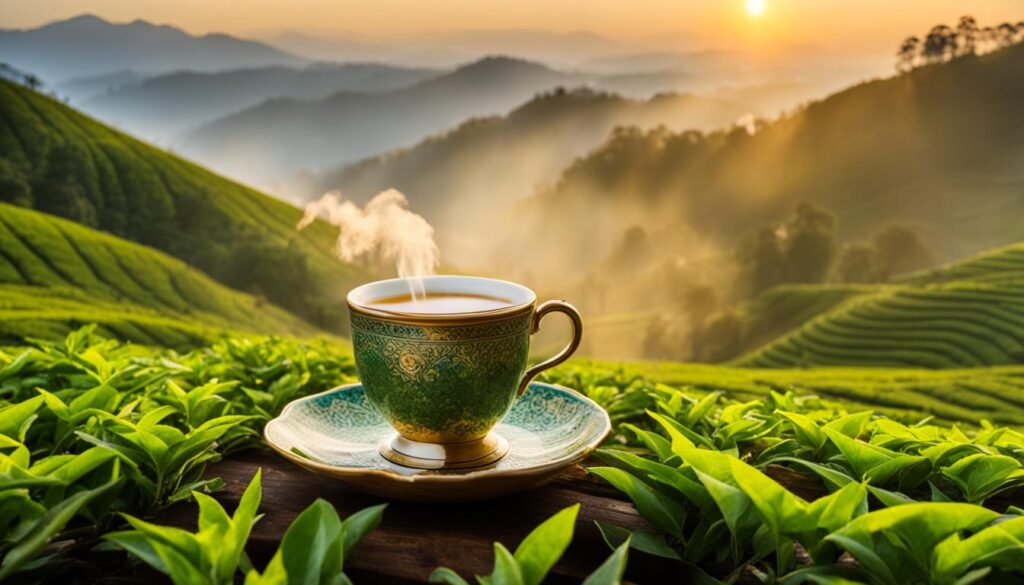
| Flavor Profile | Harvest Time |
|---|---|
| Light and mild | First flush (early in the year) |
| Musky and spicy | Second flush (harvested in June) |
Exploring the Flavors of Keemun Tea
Keemun tea is renowned for its unique flavor profile. It offers a delightful combination of a slightly smoky and fruity aroma, accompanied by a mild, almost malty taste. The tightly twisted Keemun tea leaves exhibit a captivating reddish-brown color, resembling copper. This tea is often described as well-balanced, with subtle sweetness and a hint of nuttiness, creating a truly satisfying cup of tea. Whether enjoyed plain or with milk, Keemun tea delights tea enthusiasts with its smoothness and complexity of flavors.
As someone who has explored various tea varieties, I can confidently say that Keemun tea stands out for its distinctive attributes. Its captivating aroma and well-rounded taste make it a prime choice for tea lovers seeking a truly unique experience.
Not only does Keemun tea offer a delightful drinking experience, but it also provides several health benefits. This tea is a rich source of antioxidants, which combat the harmful effects of free radicals in the body. Antioxidants help boost metabolism and improve cardiovascular health, making Keemun tea a valuable addition to a well-balanced lifestyle.
Keemun tea is not only appreciated for its flavors and health benefits but also for its cultural significance. This tea has a rich history in China and is deeply ingrained in Chinese tea ceremonies and traditions. Embracing a cup of Keemun tea allows us to connect with the rich heritage and traditions that encompass the world of tea.
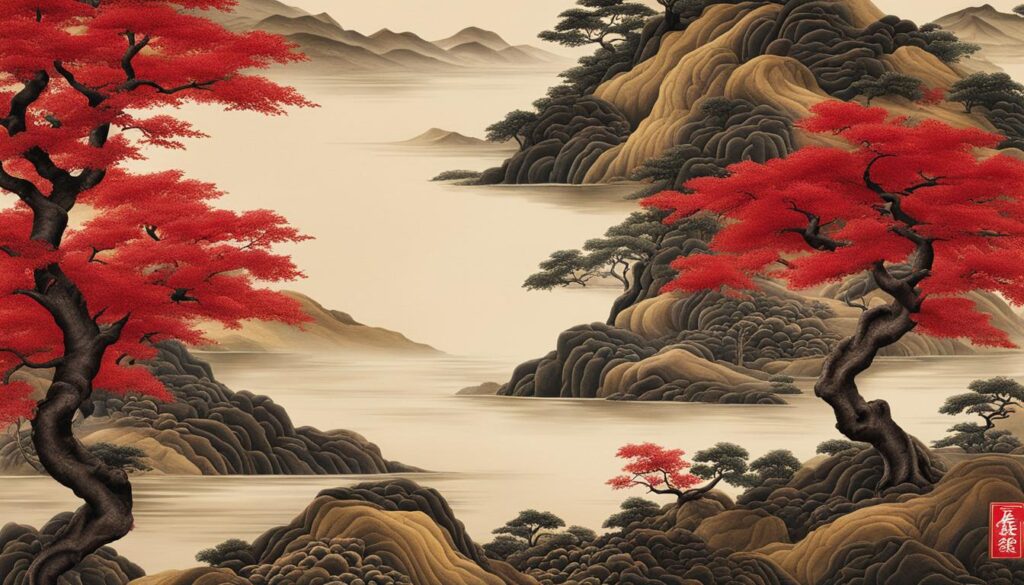
| Flavor Profile | Characteristics |
|---|---|
| Smoky and fruity aroma | Keemun tea showcases a uniquely delightful fragrance of subtle smokiness and natural fruitiness. |
| Mild, almost malty taste | The taste of Keemun tea is gentle and smooth, with hints of maltiness that add depth and complexity. |
| Well-balanced | Keemun tea offers a harmonious balance of flavors, combining sweetness, nuttiness, and subtle earthiness. |
| Tightly twisted leaves | The tightly twisted Keemun tea leaves have a visually appealing reddish-brown color, making them a true feast for the eyes. |
The flavors of Keemun tea are truly a testament to the artistry and craftsmanship involved in its production. The dedication and expertise in every step, from cultivation to processing, contribute to this tea’s distinctive character. Exploring Keemun tea is like embarking on a flavor adventure, where each sip unveils a new layer of complexity and satisfaction.
The Origins and Production Methods of Darjeeling Tea
Darjeeling tea, renowned worldwide for its unique flavor, is exclusively grown in the Darjeeling Province of India. Situated in the magnificent foothills of the Himalayan mountain range, this region offers exceptional conditions for tea cultivation. The cool and moist climate, coupled with the sloping terrain and distinct soil composition, contributes to the unparalleled taste and aroma of Darjeeling tea.
The tea gardens in Darjeeling Province are located at elevations ranging from 6,562 feet above sea level, with the highest gardens reaching up to 7,874 feet. The combination of high altitude, ample sunshine, and misty fog creates an ideal environment for the tea plants to thrive. These factors result in tender tea leaves that possess a delicate and flavorful character.
The production process of Darjeeling tea follows a meticulous approach to preserve its unique qualities. It begins with the plucking of young leaves, usually including two leaves and a bud, as they contain the highest concentration of essential oils and flavor compounds. Once plucked, the leaves undergo withering, where they are spread out on large trays to remove excess moisture. This step is crucial in enhancing the aroma and flavor of the tea.
Next, the withered leaves are gently rolled, a process that helps release the natural juices, essential oils, and enzymes present in the leaves, further intensifying the flavors. Following rolling, the tea leaves undergo oxidation, allowing them to turn from green to brown. This stage greatly influences the overall taste and color of the tea.
After oxidation, the leaves are dried using either traditional or modern methods. Traditional drying involves the use of hot air chambers, while modern methods employ large drying machines. The final result is a fragrant, flavorful tea with distinctive muscatel notes, widely regarded as the hallmark of Darjeeling tea.
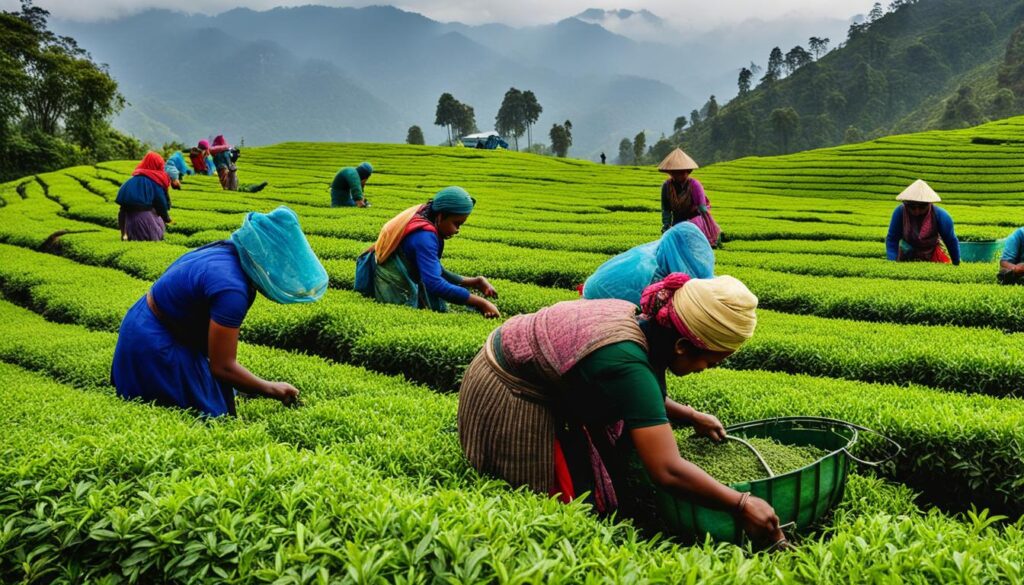
Darjeeling Tea Production Process:
| Production Stage | Description |
|---|---|
| Plucking | The tender leaves of the tea plant are carefully hand-picked, usually including two leaves and a bud. |
| Withering | The plucked leaves are spread out on trays to remove excess moisture, enhancing the aroma and flavor. |
| Rolling | Gently rolling the withered leaves helps release essential oils and enzymes, intensifying the flavors. |
| Oxidation | The rolled leaves undergo oxidation, resulting in the transformation from green to brown, shaping the taste and color of the tea. |
| Drying | The oxidized leaves are dried using either traditional or modern methods, creating the final product of fragrant and flavorful Darjeeling tea. |
The Origins and Production Methods of Keemun Tea
Keemun tea is produced in the Huangshan area of the Anhui province in China. This region is renowned for its high-quality tea, which thrives on terraces at higher elevations. The unique growing conditions in this area contribute to the distinct flavors of Keemun tea.
To create Keemun tea, the leaves are carefully hand-picked from the tea plants. These leaves are then tightly twisted, resulting in their distinctive appearance. The next step in the production process is oxidation, where the leaves are exposed to air to darken their color and enhance their flavors. Lastly, the tea is dried, bringing forth the final product.
The combination of the region’s terroir, specific cultivation methods, and tea plant varieties all contribute to the remarkable flavors and characteristics of Keemun tea.
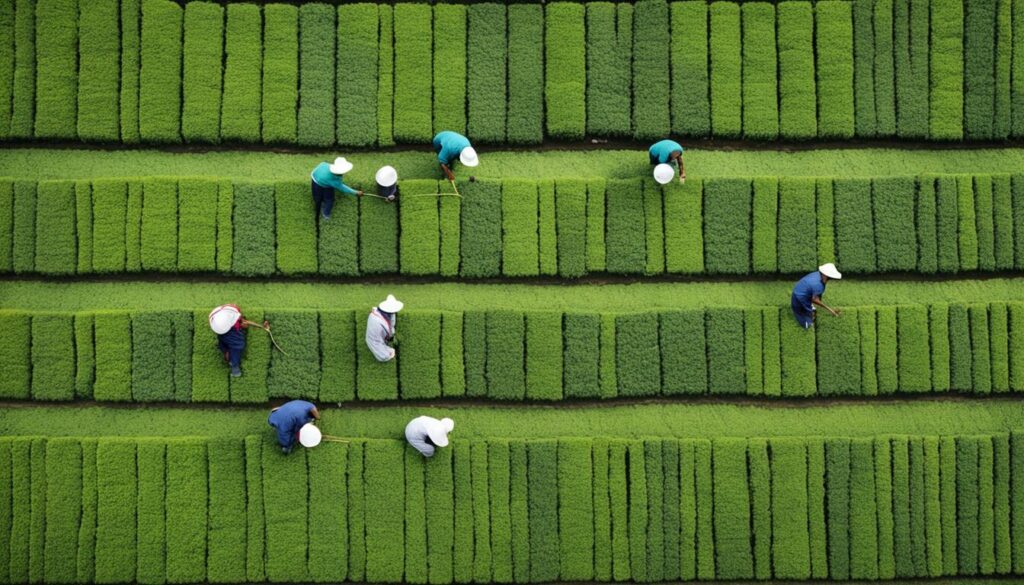
Health Benefits of Darjeeling Tea and Keemun Tea
Both Darjeeling tea and Keemun tea offer numerous health benefits. As black teas, they are rich in antioxidants that can boost the immune system, reduce the risk of chronic diseases, and improve overall health. These teas are also known to aid in digestion, promote heart health, and support weight loss.
One of the notable health benefits of Darjeeling tea and Keemun tea is their caffeine content. These teas naturally contain caffeine, which can provide an energy boost and improve mental alertness. However, it is important to consume them in moderation, especially if you are sensitive to caffeine.
Another component that contributes to the health benefits of Darjeeling and Keemun teas is the presence of polyphenols. Polyphenols are a type of antioxidant that has been linked to reducing the risk of certain types of cancers and improving gut health.
| Health Benefits | Darjeeling Tea | Keemun Tea |
|---|---|---|
| Boosts immune system | ✓ | ✓ |
| Reduces risk of chronic diseases | ✓ | ✓ |
| Improves digestion | ✓ | ✓ |
| Promotes heart health | ✓ | ✓ |
| Aids in weight loss | ✓ | ✓ |
| Provides natural energy boost | ✓ | ✓ |
| Improves mental alertness | ✓ | ✓ |
| Reduces risk of certain cancers | ✓ | ✓ |
| Improves gut health | ✓ | ✓ |
Incorporating Darjeeling tea and Keemun tea into your daily routine can be a delicious way to reap their health benefits. Whether you choose Darjeeling for its delicate and floral flavors or Keemun for its smoky and fruity profile, these teas can be enjoyed hot or cold throughout the day.
Remember to consult with a healthcare professional if you have specific health concerns or dietary restrictions.
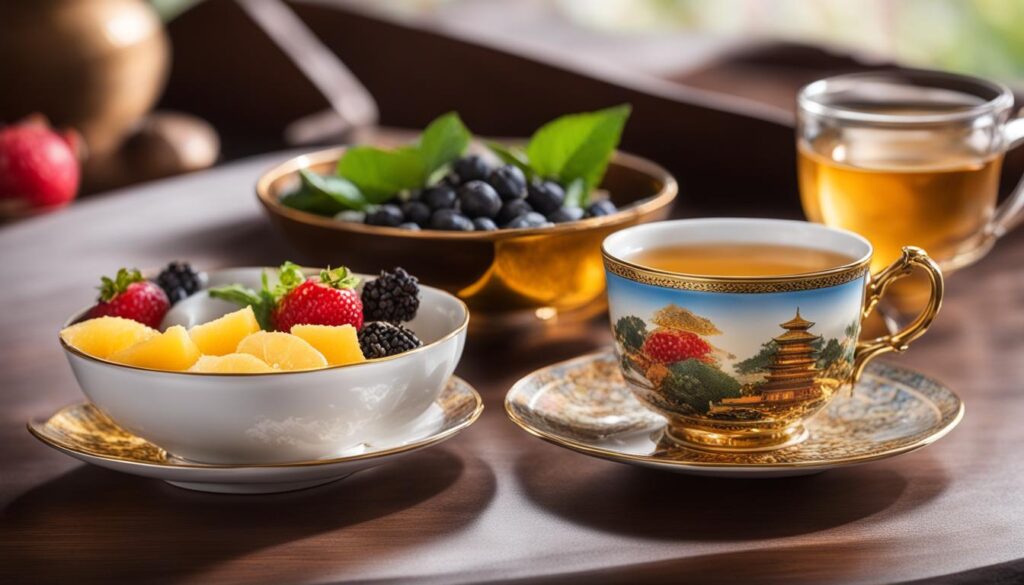
Conclusion
In conclusion, the comparison between Darjeeling tea and Keemun tea reveals two exceptional varieties of black tea, each with its own unique flavors and qualities. Darjeeling tea is renowned for its delicate and floral taste, offering a refreshing experience to tea aficionados. On the other hand, Keemun tea entices with a slightly smoky and fruity aroma, delivering a distinctive and invigorating cup of tea.
These teas originate from different growing regions and are produced using specific methods, which contribute to their individual characteristics. The Darjeeling Province of India, known for its high elevations and cool climate, produces the exquisite Darjeeling tea. Meanwhile, Keemun tea is crafted in the Huangshan area of the Anhui province in China, celebrated for its exceptional tea-growing conditions.
In addition to their delightful taste, both Darjeeling tea and Keemun tea offer various health benefits. Packed with antioxidants, these teas can boost the immune system, reduce the risk of chronic diseases, and promote overall well-being. They also contain caffeine, providing a natural source of energy and improving mental alertness. Embracing Darjeeling and Keemun teas in your routine may contribute to a healthier lifestyle.
Whether you find solace in the light and muscatel flavor of Darjeeling or the balanced and smooth taste of Keemun, exploring these teas will embark you on a delightful journey. Indulging in the world of Darjeeling and Keemun teas is a wonderful experience that will uplift your senses and satisfy your tea cravings.
FAQ
How does Darjeeling tea compare to Keemun tea?
Darjeeling tea and Keemun tea are two popular varieties of black tea with distinct flavors and qualities. Darjeeling tea has a light and floral taste with muscatel notes, while Keemun tea offers a slightly smoky and fruity aroma with a mild, almost malty taste.
What are the flavors of Darjeeling tea?
Darjeeling tea is known for its delicate and distinct flavors. It has a light and floral taste with muscatel notes. The first flush Darjeeling tea has a lighter color and a milder flavor, while the second flush Darjeeling tea offers a fuller body with musky and spicy undertones.
What are the flavors of Keemun tea?
Keemun tea has a slightly smoky and fruity aroma with a mild, almost malty taste. It is often described as well-balanced, slightly sweet, and with a hint of nuttiness. Keemun tea pairs well with or without milk and is enjoyed for its smoothness.
How is Darjeeling tea produced?
Darjeeling tea is grown in the Darjeeling Province of India, which is located in the foothills of the Himalayan mountain range. The tea plants are grown at high elevations, ranging from 6,562 feet above sea level. The production process involves plucking the tender leaves, withering, rolling, oxidation, and finally drying.
How is Keemun tea produced?
Keemun tea is produced in the Huangshan area of the Anhui province in China. The tea leaves are hand-picked and then tightly twisted. They go through a process of oxidation, which darkens their color and enhances the flavors. The tea is then dried, creating the final product.
What are the health benefits of Darjeeling tea and Keemun tea?
Both Darjeeling tea and Keemun tea are rich in antioxidants, which can boost the immune system, reduce the risk of chronic diseases, and improve overall health. These teas may also aid in digestion, promote heart health, support weight loss, and improve gut health.
How do I choose between Darjeeling tea and Keemun tea?
The choice between Darjeeling tea and Keemun tea depends on personal preference. If you prefer a delicate and floral taste, Darjeeling tea may be the better option. If you enjoy a slightly smoky and fruity aroma with a mild taste, Keemun tea is a great choice. Both teas offer unique flavors and qualities that can be enjoyed by tea enthusiasts.